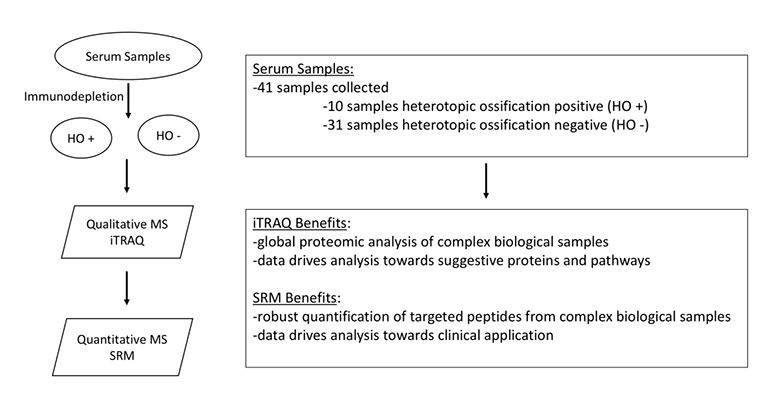Heterotopic ossification (HO) is significant problem facing Service Members who have survived combat-related blast injuries including amputation. HO is the formation of bone in soft tissues where bone normally does not form. Individuals affected by HO face numerous challenges to their quality of life, including chronic pain, difficulties fitting prostheses, and prolonged rehabilitation. The etiology of HO is not well understood, limiting the ability of clinicians to predict which patients will develop HO. Therefore, in order to prevent the development of these bony growths, biomarkers contributing to the dysregulation of wound healing mechanisms leading to the development of HO must be identified.
Researchers at the Center for Wound Healing Research at Daemen College took advantage of recent advances in high-throughput mass spectrometry (MS) to identify potential serum protein biomarkers associated with the development of HO. Briefly, researchers collected blood serum from patients with and without HO and measured the serum levels of 1,220 proteins using a technique known as isobaric tags for relative and absolute quantitation (iTRAQ). This enabled them to identify proteins that are differentially expressed between patients with and without HO (Figure 1). Using the results from the iTRAQ analysis, researchers then developed selection reaction monitoring mass spectrometry (SRM-MS) assays to more precisely quantify identified proteins. Three proteins were identified that are usually involved in normal wound healing mechanisms but that are misregulated in patients with HO; these proteins may be potential clinical serum biomarkers of HO.
Findings suggest that normal wound healing signals can impact the ability to identify biomarkers for HO; however, the identification of serum biomarkers using SRM-MS analysis may represent a solution to this challenge. A biomolecular screening tool using serum from wounded patients could allow for earlier diagnosis and intervention for patients who may develop HO as well as lead to the development of novel treatments to prevent HO from developing. This research has the potential to minimize the impact of HO on Service Members suffering from blast-related injuries, ultimately improving their quality of life.
This work was funded by the Department of Defense through the Congressionally Directed Medical Research Program, the Nemours Biomedical Research Department, and the National Institute of General Medical Sciences at the National Institutes of Health.

Edsberg, L.E., Crowgey, E.L., Osborn, P.M., Wyffels, J.T. (2017). A survey of proteomic biomarkers for heterotopic ossification in blood serum. J Orthop Surg Res. 12(1):69. doi: 10.1186/s13018-017-0567-2
Your 15 minute session will timeout in approximately 10 minutes.
If you're in the middle of entering information, please close this warning and save your progress (if possible) or finish up your task.
If your session fully times out, you will lose any un-saved work.
Your current Blast Injury Research Program session has expired.
Your next click will take you away from the private area, and you will lose any work you have in-progress.
Please enter your email address, and try again.